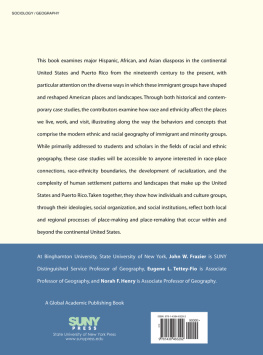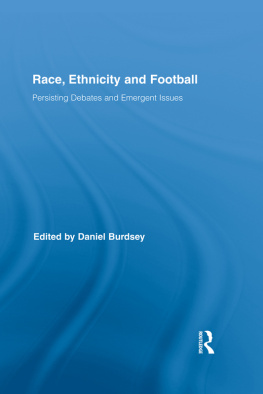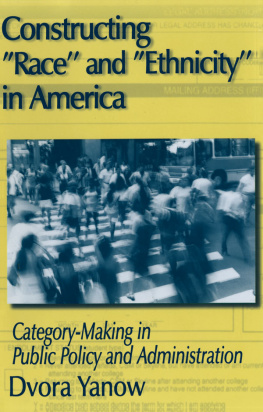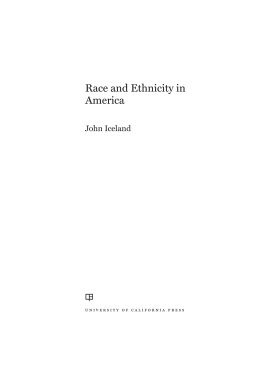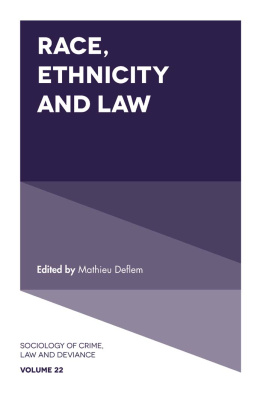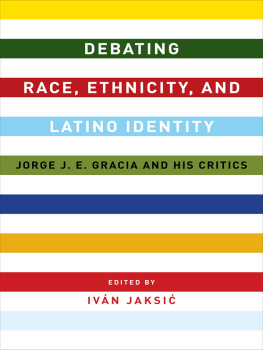Race, Ethnicity, and Place
in a Changing America
Third Edition
A Global Academic Publishing Book
Race, Ethnicity, and Place
in a Changing America
Third Edition
edited by
John W. Frazier, Eugene L. Tettey-Fio,
and Norah F. Henry
A Global Academic Publishing Book
Published by
State University of New York Press
2016 State University of New York
All rights reserved.
Printed in the United States of America
No part of this book may be used or reproduced in any manner whatsoever without written permission. No part of this book may be stored in a retrieval system or transmitted in any form or by any means including electronic, electrostatic, magnetic tape, mechanical, photocopying, recording, or otherwise without the prior permission in writing of the publisher.
For information, contact State University of New York Press, Albany, NY
www.sunypress.edu
Library of Congress Cataloging-in-Publication Data Available
Race, ethnicity, and place in a changing America, Third Edition / edited by John W. Frazier, Eugene L. Tettey-Fio, and Norah F. Henry.
ISBN 978-1-4384-6329-2 (hardcover : alk. paper) ISBN 978-1-4384-6330-8 (pbk. : alk. paper)
2016947120
10 9 8 7 6 5 4 3 2 1
Contents
Part I
PERSPECTIVES ON ETHNICITY AND RACE IN THE U.S .
| J. W. Frazier, N. F. Henry, and E. L. Tettey-Fio |
| N. F. Henry and J. W. Frazier |
| J. W. Frazier |
Part II
HISPANICS-LATINOS IN RACE AND ETHNICITY INVESTIGATIONS
| M. E. Reisinger |
| C. J. Guilbe Lpez |
| A. I. Sanchez-Rivera, J. Zambrana, C. Deng, and J. W. Frazier |
| R. C. Jones |
| H. A. Smith, J. C. Schuch, and B.U. de Hernandez |
| L. E. Estaville and E. J. Montalvo |
Part III
THE AFRICAN DIASPORA IN THE U.S .
| E. L. Tettey-Fio |
| J. A. Tyner |
| D. H. Alderman and J. Inwood |
| J. W. Frazier, R. Anderson, and J. Hinojosa |
| J. T. Darden |
| J. T. Darden and C. Teixeira |
| J. L. Newberry |
Part IV
THE ASIAN DIASPORA IN THE U.S .
| J. W. Frazier |
| W. Yu |
| L. Lo and W. Li |
| E. H. Skop |
| N. F. Henry and B. McGovern |
| E. Chacko and G. Sojo |
Acknowledgments
We are indebted to many people for their assistance in producing this third edition. To the 12 reviewers that offered suggestions for chapters, or for the entire text, we thank all of you for making this a better product. We thank the authors, who worked under a tight deadline and responded to reviewers suggestions. Many of the graphics in this text were supplied by the authors. However, a significant number were produced by Kevin Heard, Assistant Director of the Binghamton University GIS Core Facility, and by Lucius Willis, GIS Analyst. We also thank Sean McGovern for supplying a number of photos for Queens, New York. Special thanks are due to Brendan McGovern, Operations Coordinator, Geography, Binghamton University, who provided guidance to authors, standardized the graphics that appear here, and served as an author. Thank you, also, to John Ponstingel for proofreading the entire manuscript several times.
We are extremely grateful to Lori Vandermark-Fuller, who worked diligently on typesetting the book and made other contributions to the book. We extend our gratitude to James Peltz, Co-Director, SUNY Press, for endorsing the publication of this edition, and to Ryan Morris, our Production Editor.
JWF ETF NFH
Part I
PERSPECTIVES ON ETHNICITY AND RACE IN THE U.S.
The three chapters in also discusses immigration trends and relates changing origins of the U.S.-foreign born to changes in immigration laws. The evolving human geography, including ethnic patterns, can be understood best by such institutional actions, as well as by global processes and local decisions.
also offers definitions, as well as examples of concepts related to these themes.
Race, like ethnicity and place, is a social construction. However, the processes influencing race and ethnicity differ dramatically.
Chapter 1
Culture, Ethnicity, and Place in a Changing America
A Perspective
J OHN W. F RAZIER , N ORAH F. H ENRY , AND E UGENE L. T ETTEY -F IO
PERSISTENCE AND CHANGE IN AMERICAN HUMAN GEOGRAPHY
Culture, and the human geography it produces, persist over a long time period. However, culture changes slowly, as do the visible landscape it produces, and the ethnic meanings imbued by the group that shapes it. That many examples of persistent and new cultural landscapes exist in the U.S. is not surprising, given the major technological, demographic, and economic changes in American society since World War II (WWII). America emerged from WWII as one of two superpowers, developed and embraced technology that took Americans to the moon, created an electronics revolution that greatly modified the ways that Americans work and live, and built a globally unique interstate highway system, new housing stock, millions of additional automobiles, and otherwise increased its production to meet the challenge of nearly doubling its population between 1950 and 2000. The Post-WWII baby boom and massive immigration fueled population growth and modified American society in important ways, creating different needs and growing aspirations. A larger African-American middle class also emerged during this Post-war period. Leadership in a growing global economy enabled unprecedented economic growth that supported these changes.
This book tells the story of the changing faces of the U.S. since WWII and the roles that various groups have played in altering the cultural landscapes and racial geographies of America. Aimed at the broadly-inclusive cadre of students of American culture and culture change , this work examines some of the more important cultural, racial, and ethnic changes of the 1940s through the first decades of the 21 st Century. Both events and concepts illuminate the changes in America resulting from international migration-pattern changes, U.S. internal migration and mobility patterns, social, racial and ethnic implications of the changes, and the role that technology plays in our ability to comprehend the depths of the cultural changes. Our goal is not to reveal all depths and dimensions of U.S. culture, for that would be impossible. However, by presenting and illustrating contemporary, cogent examples of race, ethnicity, and culture in 21 st Century America, we provide a unique foray into multiple ethnicities, cultures, and landscapes from varied perspectives to illustrate the growth, ethnic and racial mix, and changes that have occurred over the past 75+ years. We begin with an overview of trends to provide background and perspective, and follow with conceptual dimensions and technological advances that provide both an intriguing, and occasionally disturbing, view of progress and how it has affected different groups.
We begin by explaining the components of race, ethnicity, and culture that express the issues contained in the chapters of this book. We then look at the influence of both international and domestic groups who shifted locations to create the fabric of American society as we know it today. The groups, the shifts, and the resulting events and patterns provide the altered social and cultural landscapes that describe contemporary America.

